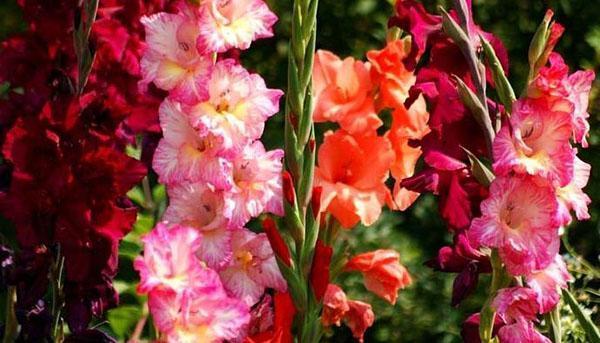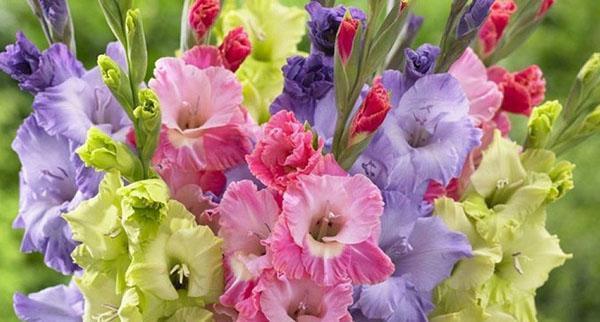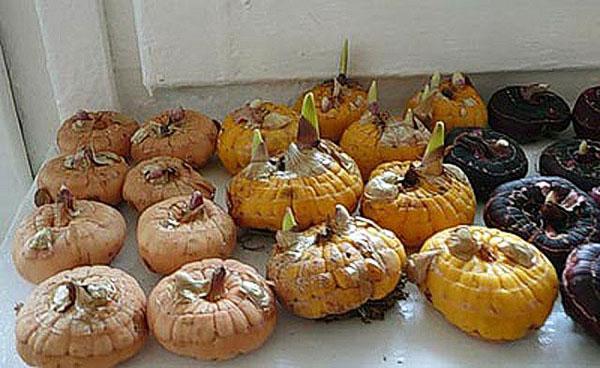Features of planting and caring for gladioli in Siberia
 This delicate and elegant flower is a decoration of any garden and is not at all as capricious as it seems. Even living in Siberia, you can successfully grow gladioli, observing the rules of planting and care.
This delicate and elegant flower is a decoration of any garden and is not at all as capricious as it seems. Even living in Siberia, you can successfully grow gladioli, observing the rules of planting and care.
Briefly about gladioli

For growing gladioli in Siberia, varieties with an early or medium flowering period are suitable so that the bulbs have time to ripen.
Site selection and soil preparation for gladioli
The best site would be a sunny spot on the south side, protected from cold winds and without stagnant groundwater. A fence, a wall of a house or a trellis with climbing plants... These flowers do not tolerate swampy lowlands. If the site is located low, you need to make a high bed with drainage under the gladioli. Spring preparation of gladioli for planting in Siberia begins in the fall. The selected area is dug up, freeing from weeds, and fertilizers are added:
- phosphorus, potash,
- ash,
- rotted manure or compost.
For heavy clay soils, sand should be added.
All fertilizers are applied deeply, since the root system of gladioli forms two tiers and goes to a depth of 30-40 cm.
Spring preparation of corms and germination
 The timing of planting gladioli in Siberia may shift depending on your region and area. You need to focus on the temperature of the soil. By the time of planting, it should dry out and warm up to 10-15 degrees. This usually happens in the first half of May.
The timing of planting gladioli in Siberia may shift depending on your region and area. You need to focus on the temperature of the soil. By the time of planting, it should dry out and warm up to 10-15 degrees. This usually happens in the first half of May.
A month before the expected planting date, the bulbs should be prepared:
- remove from storage and clean from dry shells;
- carefully examine and reject dry and sick;
- treat the bulbs with potassium permanganate and any antifungal drug - "Maxim", "Fundazol";
- for earlier flowering, you can soak the bulbs in growth stimulants - "Epin", "Energen".
 When the gladiolus bulbs are disinfected, germination can begin. In Siberia, this procedure will help to achieve earlier flowering and successful maturation of planting material. A warm, light room with moderate humidity is suitable for germination. The tubers are laid out with the bottom down in one layer. An escape should appear on them in 10-15 days.
When the gladiolus bulbs are disinfected, germination can begin. In Siberia, this procedure will help to achieve earlier flowering and successful maturation of planting material. A warm, light room with moderate humidity is suitable for germination. The tubers are laid out with the bottom down in one layer. An escape should appear on them in 10-15 days.
If shoots have not appeared in 2 weeks, the planting material is not suitable for planting.
How to grow gladiolus seedlings
 If the variety does not differ in early flowering dates, the flower can be grown by seedling. In Siberia, gladioli should be obtained for germination for seedlings at the end of winter, at the time when sowing of peppers and eggplants usually begins. After preparation, the tubers are planted in boxes with fertile soil to a depth of 1-1.5 cm. The soil is kept moderately moist. The boxes are placed in a warm, lit place.At the time of planting in the ground, the seedlings should have a developed root system and several leaves.
If the variety does not differ in early flowering dates, the flower can be grown by seedling. In Siberia, gladioli should be obtained for germination for seedlings at the end of winter, at the time when sowing of peppers and eggplants usually begins. After preparation, the tubers are planted in boxes with fertile soil to a depth of 1-1.5 cm. The soil is kept moderately moist. The boxes are placed in a warm, lit place.At the time of planting in the ground, the seedlings should have a developed root system and several leaves.
Planting gladioli in the ground
 The spring planting of gladioli in open ground in Siberia coincides with the time when the soil warms up to 8-10 degrees and there is no probability of night frosts.
The spring planting of gladioli in open ground in Siberia coincides with the time when the soil warms up to 8-10 degrees and there is no probability of night frosts.
Replacement bulbs and babies dug up in the fall are suitable for planting. Gladioli can be planted in furrows or by the nesting method in flower beds. The bulbs are placed on a handful of dry sand, to a depth of 5-8 cm, the distance between them in a row should be 10-15 cm, and between rows - 25-30. Children are planted to a depth of 3-4 cm, making intervals of 2-3 cm. They are pre-soaked for a day in warm water. After planting, the holes are watered with warm water.
Peduncles should be cut off in children in order to get a large marketable bulb in the fall.
Gladioli care
 Correct fit and competent gladioli care will provide powerful growth and abundant flowering even in the harsh Siberian conditions.
Correct fit and competent gladioli care will provide powerful growth and abundant flowering even in the harsh Siberian conditions.
Before sprouting, tubers should be watered very sparingly and carefully so that the soil does not compact. After the first shoots appear, watering is increased. It is better to water not at the root, but in the grooves nearby. The soil under the flowers is regularly loosened to allow air to flow to the roots, and weeds are removed. After the appearance of peduncles, tall varieties are necessarily tied to pegs.
Protection from pests and diseases
 Gladioli are susceptible to fungal diseases and thrips. Reduces the likelihood of fungal diseases proper preparation of planting material, proper care and timely spraying of plants. Diseased specimens should be removed from the garden along with a lump of earth, shed this place with any fungicide, then spray the remaining healthy bushes with it.
Gladioli are susceptible to fungal diseases and thrips. Reduces the likelihood of fungal diseases proper preparation of planting material, proper care and timely spraying of plants. Diseased specimens should be removed from the garden along with a lump of earth, shed this place with any fungicide, then spray the remaining healthy bushes with it.
Treating thrips with such preparations as "Decis", "Iskra", "Actellik", "Fufanon" helps.
Disease prevention consists in moderate watering, non-thickened plantings and weed control.
Collection and storage of planting material
 Collect the bulbs and babies for storage in the fall, before the onset of frost. They are believed to mature fully 35 days after flowering. The plants are carefully dug up with a shovel or pitchfork, being careful not to damage. After digging, you need to shake off the ground and cut off the stem. After that, the tubers are laid out to dry.
Collect the bulbs and babies for storage in the fall, before the onset of frost. They are believed to mature fully 35 days after flowering. The plants are carefully dug up with a shovel or pitchfork, being careful not to damage. After digging, you need to shake off the ground and cut off the stem. After that, the tubers are laid out to dry.
In the apartment they can be stored in the refrigerator, wrapped in several layers of newspapers and a plastic bag. Holes for ventilation must be made in the package. Also, planting material can be stored in a dry and clean cellar.
Thus, observing these simple rules of planting and care, gladioli can be grown even in Siberia. Several early varieties with different flowering times will delight the skilled gardener almost all summer.